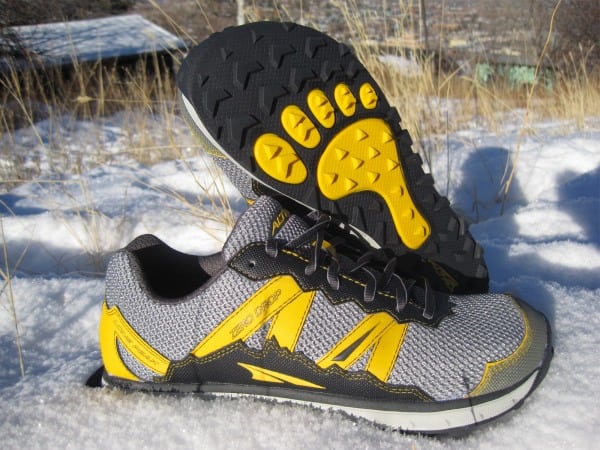Check out our Altra Lone Peak 9 review for the latest on the Lone Peak family of trail running shoes.
Our Favorite Trail Running Shoes
Check out our Best Trail Running Shoes article to learn about our current favorite trail running shoes!
Altra Lone Peak Review
The Altra story is a compelling one. Two friends are selling shoes at the family running specialty store, Runner’s Corner in Orem, Utah, and they start zero dropping traditional running shoes to see if they could prevent injuries. Word of mouth spreads and soon they are firing up the bandsaw to zero drop shoes for friends of friends. The pair initially tried to pitch their zero drop idea to established shoe companies and were mocked, but little did they know that Born to Run would be released around the same time. In the summer of 2009, Altra was born with a focus on developing anatomically correct footwear with zero heel-to-toe drop, a concept that has caught on a great deal over the past several years.
The Lone Peak ($110) is Altra’s only trail shoe, designed to withstand the rigors of the Wasatch 100. This zero-drop, 11.3 ounce beast provides the only zero drop shoe on the market that is protective and not minimal.
Upper
When I first put on the Lone Peaks, it felt like they were too big. My forefoot and toes had so much room initially worried that I needed to size down. Apparently this is a common response to wearing the Lone Peaks for the first time, as most of us are used to having our toes crammed into a traditional running shoe toe box. After a wearing the Lone Peak around for a few days, I started to relish the extra room the foot-shaped design afforded me.
The Lone Peak features a soft, dual-density mesh upper with an asymmetrical lacing system that provides a stable, but not too snug fit. The heel cup is soft and fits well, and the heel collar is wicking and non-abrasive. Synthetic overlays throughout the upper are well placed and sewn on, rather than welded on like many new trail shoes we see out today. The overlays provide additional support throughout the upper, what Altra calls their A-wrap, but also have an aesthetic purpose. The thin rubber toe bumper appears to be the rugged peaks of the Wasatch Front. The rand on the medial and lateral sides of the shoe is made of the same durable rubber material and features a similar mountain silhouette. The stitching appears big and durable and reinforcements are placed in all the necessary areas of the shoe. Altra boasts that the Lone Peak can last 1,000 miles and they’ve certainly built an upper along those lines.
From an aesthetic standpoint, these shoes look pretty cool in my opinion. I felt like I was wearing some original Adidas Response Trails and I got many compliments from other runners.
Midsole
Altra uses a two-layer midsole using a softer EVA (A Bound Midsole) on top and a firmer more resilient EVA (zero drop) on the bottom. Sandwiched between the two layers is a thin Stoneguard rock plate that is flexible, yet effective. This concept is different from conventional trail shoe construction which places the rock plate between the midsole and the outsole. I was surprised to learn that the shoe contained a rock plate after my first few runs in the Lone Peak featured some very sharp and rocky sections. You certainly can’t feel the rock plate, but my feet felt well-protected and my foot plant never lacked confidence throughout my runs.
The cushioning of the Lone Peak is soft and responsive, but has a firmness underfoot, as well, which seems to provide a quick transition and toe off. Stability is achieved by a low overall stack height and the wide platform of the shoe. There isn’t a noticeable arch in the shoe and the only feel of an arch is from Altra’s Off Road insole which features a small arch bump without providing support. There are no additional stability devices such as a medial post.
Outsole
The Lone Peak’s outsole is made of a sticky carbon rubber which Altra calls their Trail Claw Outsole. The surface area of the outsole is quite large and it doesn’t feature any cutouts. The lugs are largest under the forefoot and provide a good deal of traction running uphill. These large lugs are widely spaced and do seem to shed mud and clay well enough. The traction properties of the Lone Peak are not extreme by any means, but certainly enough bite in most conditions.
The most curious aspect of Lone Peak’s outsole is the Trail Rudder, which is aimed at providing stability on steep or loose downhill sections. I tested this feature to the best of my ability and my final verdict is that I don’t notice it aiding or hindering on any terrain. Many runners will likely choose to simply cut it off which is easily accomplished.
Overall Impressions
The Altra Lone Peak is very simple, well-cushioned, zero-drop shoe that is built to last. I have no doubts, after well over 100 miles of tough trail running in my Lone Peaks, that these shoes would last 1,000 miles as Altra claims. The upper seemed to shed any dirt or debris quite easily and my Lone Peaks barely show any sign of wear. I did run through a few creeks and found that the porous mesh shed water fairly quickly.
My favorite aspect of the Lone Peaks is the cushioning which seems resilient, but not thick. The placement of the rock plate between the two foam layers adds a necessary and appreciated level of protection, but the Lone Peak stays very flexible throughout foot plant and toe off.
I did my best to follow Altra’s booklet full of guidelines for transitioning into the Lone Peaks when you start wearing them, but I couldn’t help myself. They are just too fun to run in. Mind you, these aren’t minimalist trail slippers, but more like a smooth riding Continental from the 70s with great shocks. Comfortable, durable, and ready for all day on the trails. I would recommend that one heeds more caution than I did, and do not head directly out the door for 10 miles on the trails unless you are used to zero drop shoes. I spend several days weekly in a 4mm drop, but zero drop is an entirely new level. I found myself appropriately forefoot striking for much of the run and returned with some sore calves. But, if I was looking for a zero drop everyday training shoe, the Lone Peak would get the nod. I also used the Lone Peak as a fantastic recovery shoe and the combination of the wide toe box and zero drop are a joy to wear around after a hard day on the trails.
Call for Comments (from Bryon)
- If you’ve worn the Altra Lone Peaks, what do you think?
- What about Altra’s other models?
- Overall, what are your thoughts on the concept of a cushioned, protected zero-drop trail shoe?




